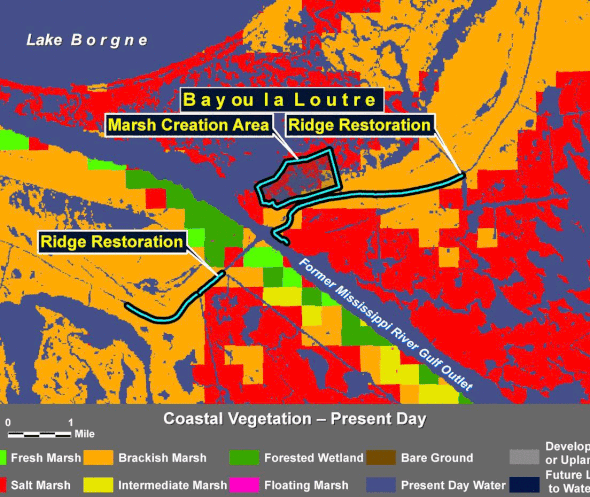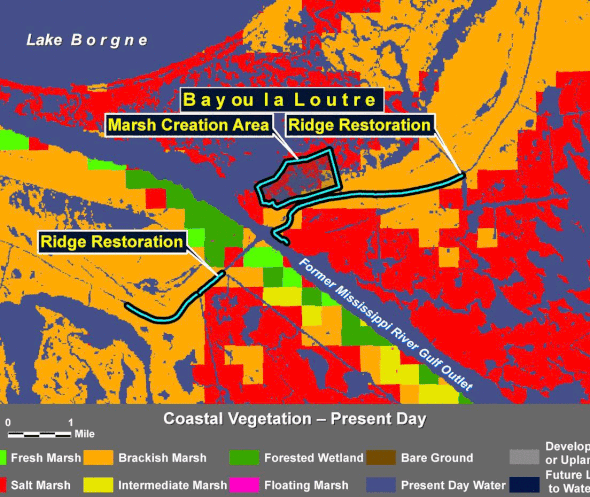This Ridge in St. Bernard Parish is in Dire Need of Restoration
To restore Louisiana’s coast, we need a suite of large-scale restoration projects across the coast working together to deliver maximum benefits to reduce land loss, restore ecosystems, and maintain healthy and diverse habitat. In our “Restoration Project Highlights” series, we take a deeper look at specific projects from our list of Priority Projects, highlighting why they’re needed and hearing local perspectives on importance.
Across its coast, Louisiana has many natural ridges that are the elevated banks of former river channels that are now bayous. In New Orleans, Bayou St. John, for example, was a former channel of the Mississippi River. When the river’s path changed course, the bayou and the elevated banks of the former river channel remained. More than 95 percent of Louisiana’s forested ridge habitat has been lost since European settlement, according to the Louisiana Department of Wildlife and Fisheries.
This is a huge loss for coastal Louisiana because ridges play an important role in our coastal ecosystems by balancing how water moves and preventing saltwater intrusion that can lead to land loss. However, restoration efforts can help save some of the ridges that remain.
Plans underway aim to restore and preserve the Bayou la Loutre ridge, the narrow banks of Bayou la Loutre, an ancient channel of the Mississippi River extending across St. Bernard Parish.
What is Bayou La Loutre Ridge?

Photo by John Harding, Creative Commons
Bayou la Loutre Ridge (“loutre” is French for “otter”) is located in St. Bernard Parish. The bayou and ridge run along the community of Yscloskey, making their way to Hopedale Marina where they’re sliced by the Mississippi River Gulf Outlet (MRGO) shipping channel, and eventually winding through the Biloxi Marsh until the bayou empties into Bay Eloi and the Chandeleur Sound.
Changes in hydrology due to channels like the MRGO, boat traffic and subsidence has caused heavy erosion on the ridge, leaving it in dire need of restoration. The State Natural Heritage Program lists the ridge as Most Critically Imperiled. Restoration of Bayou la Loutre Ridge will bring increased protection from hurricane winds, storm surges and waves, as well as improved fish and wildlife habitat. A restored ridge would also continue to mitigate the devastating historical impacts of the MRGO.
What Progress Has Been Made to Restore the Ridge?
Several planning steps have been taken to restore Bayou la Loutre Ridge, though most of the actual construction of ridge restoration has yet to commence. By far, the rock dam closure of the MRGO has had the greatest positive impact on the ridge to date. When the MRGO was constructed in the early 1960s, the deep-draft shipping channel cut Bayou la Loutre and its adjacent ridge. This breaching of the ridge caused massive saltwater intrusion.

The rock dam constructed on the Mississippi River Gulf Outlet helped restore the hydrology of Bayou La Loutre, but we still need to restore the erosion of the ridge.
Because of this, the 2009 closure of the channel – with a rock dam – was positioned just south of the Bayou la Loutre and reconnected the flanking ridge to restore the natural hydrology of the area. One of the most telling signs of the rock dam’s impact on the ridge is the recent new growth appearing on massive Live Oaks that were thought to be dead for decades. The Lake Pontchartrain Basin Foundation has documented this regrowth. By balancing salinity, what was once thought dead is now reborn.
The rock dam is very effective to restore the natural water flow, but it didn’t restore the remaining ridge itself. That effort is included as a project in the state’s 2017 Coastal Master Plan. The plan calls for 20 miles of ridge restoration between 2028 and 2047. Meanwhile, the Coastal Wetlands Planning, Protection, and Restoration (CWPPRA) Program is designing a 5.5-mile ridge restoration project along the bayou with 421 acres of marsh to be restored adjacent to the ridge.
The project is in engineering and design and is expected to be ready for Phase 2, or construction, in late 2020. At that time, anyone who’d like to support the project will have an opportunity to submit comments to the CWPPRA Technical Committee for consideration during the vote to move the project forward.
What Does A Future Without Action Look Like?
Future with action assumes all projects in the 2017 Coastal Master Plan are operating.
What does a future without action look like? |
What does a future with action look like? |
 |
 |
Wildlife Love Bayou la Loutre Ridge
Not only is the ridge’s Live Oak-Hackberry maritime forest habitat important for wildlife such as squirrels, opossums, racoons, but it’s often the first and last stop for hundreds of thousands of migratory birds crossing the Gulf of Mexico.

A Painted Bunting perches on a relatively sturdy bit of grass. Photo by Chris Johnson, National Audubon Society
The Painted Bunting is one of the many migratory birds that rely on Bayou la Loutre ridge as a resting stop on their migratory journeys. One of the most beautiful songbirds in North America, the French name, nonpareil, means “without equal.”
Painted Buntings also use the ridge habitat for breeding, as they like a tree marsh interface.
As a result of the MRGO closure with the rock dam, salinity north of the rock dam is much closer to its historic condition, which supported wildlife such as the bayou’s cute namesake – the river otter.
Reports of the otter in nearby waterways has been increasingly common lately, but not yet in the “Bayou of the Otter.” Stay tuned!